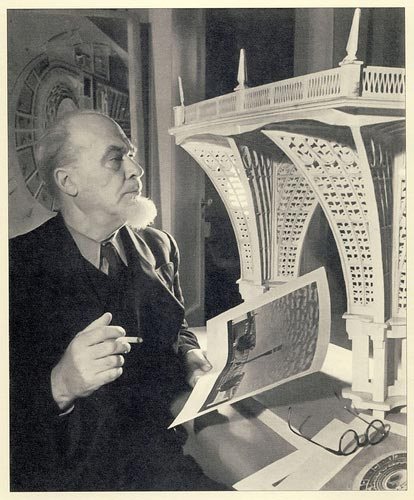
In 1923, a graduate and teacher, head of the Department of Engineering of the Institute of Civil Engineers (IGI, now SPbGASU), architect Aleksandr Sergeevich Nikolsky (1884–1953) organized a creative workshop at the university, where he completed a number of significant projects. Together with the architect A. A. Ol, he developed a new program "Introduction to Architecture", which was focused on exercises on abstract examples, unrelated to material and design, forming the spatial thinking of students.
In 1932, the country's leaders entrusted Aleksandr Nikolsky with designing the world's largest stadium in Leningrad, which was supposed to become not just a sports facility: they planned to turn Krestovsky, Elagin and Kamenny Islands into a grandiose garden city, and erect an all-Union stadium for one hundred thousand spectators as a triumph of revolutionary will. The architect was inspired by the work, despite the difficulties: the selected site was unsuitable for construction, and in 1933 work began on draining it. Nikolsky came up with the stadium, which was an artificial hill made of soil raised from the bottom of the Gulf of Finland, with an oval bowl in the middle and stands located around it. Rising 16 meters above sea level, the stadium was facing the park and the bay with its outer landscaped slopes.
In 1936, Adolf Hitler opened the Olympic Games at the new stadium in Berlin, and the foundation was laid on Krestovsky Island. Then no one in the USSR could have thought that after five years all, even the most ambitious, projects would be in jeopardy - Germany would treacherously attack the Soviet Union. Two months before the start of the war, Nikolsky was temporarily suspended from the project, but even in besieged Leningrad, he continued to paint pictures of an ideal park. In the first months of the war, Aleksandr Nikolsky worked on the album "Leningrad in the days of the blockade" and performed a number of draft designs. Among them were triumphal arches conceived already then, in the most terrible blockade time, for the future meeting of the victorious Red Army, and monuments dedicated to the defense of the city.
“For a month and one day, the city was bombed, for a month and one day, my wife and I were stuck in the attic of our ZhAKT (housing and rental cooperative partnership). For a month and one day we listened in the crown of the attic to the heart-wrenching singing of German engines, the whistle of bombs full of agonizing expectation, and gently swayed together with the house from the explosion, this time the bomb that didn’t hit us ... Insomnia has completely taken over us. You bet! Combat alarms began regularly from 6–7 p.m. and, with short breaks, lasted all night until 6 a.m. And thus for every night. Therefore, I stayed up all night and used the intervals between alarms to work - I continued to make drawings for my stadium and thus spent time until 6 in the morning. I slept until 10 a.m., in spite of everything, and at 10 I raised either by an air raid alarm or an impossibly strong bombardment. There were more than a dozen alarms in some days. And so we lived ... ”- Aleksandr Nikolsky wrote in his diary.
In his manuscripts, the architect admits that when he and his wife, Vera, moved to the Hermitage bomb shelter, it was a big weight off our shoulders, and the impressions of the reality we experienced pushed thoughts related to the stadium into the background: a new, more current issues appeared. “When I moved to the Hermitage, I began to paint partly from nature, partly from memory and impressions. In October I painted bomb shelters from nature, in November, from impression and memory, the Neva with ships, in December, the halls, rooms and passages of the Hermitage. The entrance to the bomb shelter was from the courtyard under the arch. At night, the way to the bomb shelter through the passages and halls of the Hermitage was truly fantastic to the point of creepiness. There was no blackout on the large museum windows and, therefore, it was impossible to turn on the light. Therefore, at the ends of the twenty-column hall, there were accumulators with small electric bulbs on the floor. Everything else was black as soot, only a small light flickered below - you had to go to it, then turn left, to the exit to the courtyard, and from the courtyard to the bomb shelter - the basement under the Italian halls ... ", - wrote the architect.
In February 1942, the City Council created a group of architects remaining in the city to develop a plan for the restoration and development of Leningrad, which included Aleksandr Nikolsky. The group worked in the cellars of the Hermitage, creating a project for the future city.
In 1942–1944 Aleksandr Nikolsky worked in the evacuation in Yaroslavl, wh ere he developed projects for a sports complex for Novopetrovsk, adobe houses for the countryside, a monument to the "Patriotic War" and a stadium for fifteen thousand seats for Yaroslavl. Throughout the war years, the architect remained devoted to his chosen cause, firmly believed in the Victory and the significance of the projects he created: the country would need to be restored.
He was right about everything. Already in 1944, immediately after the blockade was lifted, Leningrad began to be rebuilt according to the project created by the working group, and in the victorious 45th, after a radical reconstruction of the territory that had suffered during the war, the sports park was recreated according to the new Nikolsky project and renamed the Primorsky Victory Park .
Other materials of the "Scientific Regiment" project: